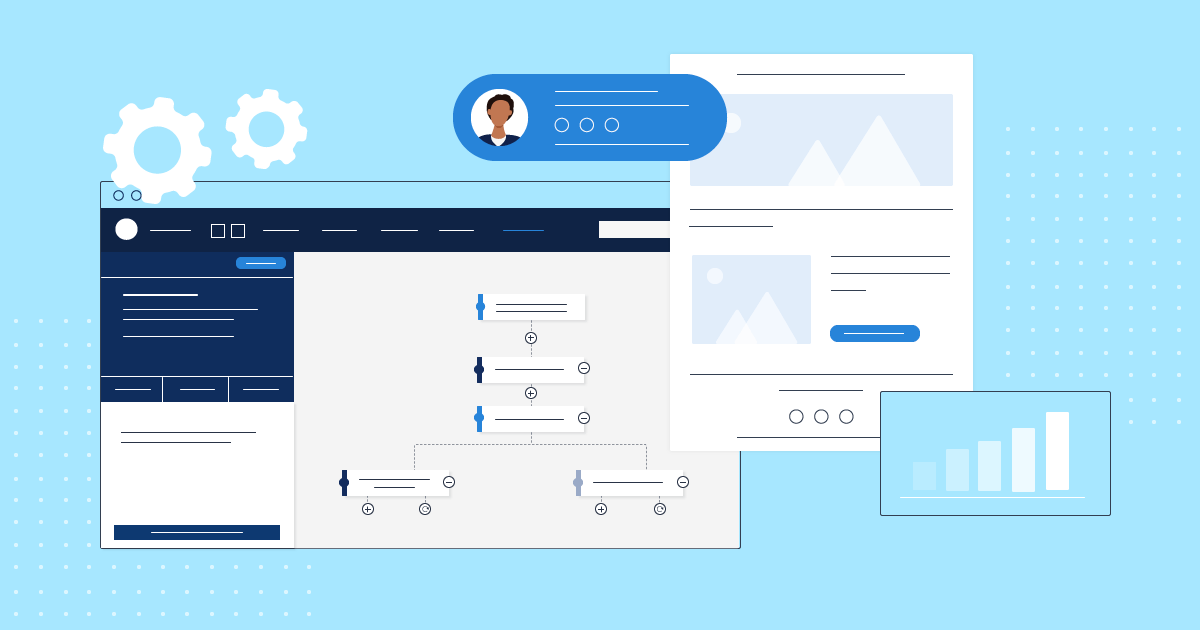
Email Sequences: 9 Types & Best Practices For 2025
Marketers always seek new, efficient methods to personalize customer experiences while staying on budget. But budget constraints isn’t the only thing they worry about.
Determining where to focus their time and energy is another common headache. Here’s where email sequences enter the game.
With this valuable tool, you contact subscribers when they’re more likely to notice and act on your message. Plus, you reduce workload so you can take on more strategic projects.
In this guide, you’ll learn about automated series and why you need them. We’ll also list the top email sequence types to target your audience with the right message at the right time, plus tips to set them up.
Give your audience the sequel they need
Craft email stories that hook subscribers, from first hello to lasting loyalty.
Join MoosendWhat Is An Automated Email Sequence?
It’s a series of automated emails triggered by specific user actions or behaviors. Businesses schedule these emails to land in inboxes at critical times of the customer journey, serving objectives like lead nurturing or customer re-engagement.
A common example is an abandoned cart sequence, which aims to recover lost sales by nudging people who showed interest in your products but left before buying.
There are two main types of email sequences:
- Trigger-based follow-ups are activated when a visitor or customer has completed a particular action, such as a resource download.
- Time-based emails are sent after a certain amount of time has passed or at a specific date (like the recipient’s birthday).
To schedule these automated emails, your safest bet is powerful email marketing automation software like Moosend or Mailchimp, with a user-friendly automation builder and ready-made workflows and email templates to free your hands.
Why Should You Use Email Sequences?
Moving to the “what’s in it for you” part, here are the main benefits of using sequenced emails:
- Driving conversions: Delivering targeted and timely content increases the chances of moving your audience down the funnel. For instance, a SaaS business may send demo invitations to free trial users one week before the expiration date to showcase the value of upgrading.
- Increasing sales: When prospects receive relevant emails that answer questions or handle objections, they know they can trust you. So, they’re more likely to purchase. Let’s take the abandoned cart example, where a brand could send a small discount to persuade people to complete checkout.
- Retaining customers: Sequenced emails helps you keep your business top of mind and engage in ongoing dialogues. For example, you can nurture loyal customers with exclusive offers and content or re-engage dormant ones with personalized product recommendations.
- Ensuring scalability: Automated email sequences allow you to set the right emails once and deliver value like clockwork without extra effort. More importantly, you can send the right message to all recipients regardless of the list size, as long as you don’t exceed your plan’s contact limits.
Top Email Sequence Types With Examples
But what does sending the right sequences mean? First, we should mention that which types and tactics you use depends on your industry and objectives.
For instance, a hotel that wants to enhance the guest experience, booking confirmations and upgrade offers are common choices.
Whereas a nonprofit organization looking to encourage community engagement will probably spotlight volunteers or promote events.
So, let’s check out the most popular email sequence types, along with examples of brands getting them right:
1. Welcome email sequences
Welcome emails is an ace on every marketer’s sleeve, as it’s the first touch point after a prospect or customer has expressed interest in your products or services.
Since recipients expect such an email after email sign up, it’s an excellent opportunity to nail first impressions and form expectations on future communications.
Here’s how you’ll do it:
- Start by thanking them for subscribing, perhaps using a warm note from the founder or CEO.
- Keep things simple (this usually means short, too) to avoid overwhelming recipients; remember, most of them aren’t committed to your brand yet.
- Use a second or third email to start promoting your offerings. A first-time discount works wonders to encourage purchases without sounding pushy.
- Ensure on-brand email design, copy, and tone to familiarize people with your identity.
Let’s have a look at an effective welcome example by Allkinds.
Subject line: Welcome to Allkinds🚿 🎨 🧇 ⚽️ 🏖️ 👾 ✨👀

Why it works:
- Simple and straightforward email subject line
- Clean design with plenty of white space but no long chunks of text
- Presents benefits in a fun, digestible format
- Playful look and feel that matches the brand’s style from subject line to visuals
- Compelling discount on the next order
Looking to create your first welcome email? Sign up for a Moosend account, search for our ready-made welcome email sequence, filter contacts as you please, and give new subscribers the welcome they deserve.
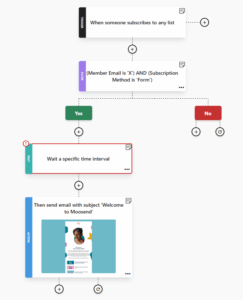
2. Onboarding emails
Similarly to welcome emails, onboarding series play an important role in how new recipients perceive your brand.
But an effective onboarding email sequence should also lead your audience to the ‘aha moment’ that reaffirms their decision to invest in your brand.
It helps to consider these sequences as a step-by-step guide that educates new customers. Which is why they can reduce redundant customer support tickets, when done right.
So, schedule a series of emails that will be rolled out after they join your list. Especially for B2B companies, onboarding series allow you to prepare new clients for success by:
- Offering essential resources, links, and FAQs to resolve issues and answer questions.
- Showcasing key features in mini lessons that don’t frustrate users.
- Sharing social proof like success stories to help them visualize key use cases.
Let’s have a look at how monday.com approaches user onboarding, starting with their welcome email.
Subject line: Welcome to monday.com

Why it works:
- Clear copy that mentions what to expect
- Visible CTAs prompting readers to set up their account
- Friendly and positive language
- List of helpful options so users can find their way through the platform
Down the line, monday.com users receive onboarding material to create and organize their first projects:
Subject line: Build your first project in 3 steps

Why it works:
- Breaks project building in three straightforward steps
- Easy-to-skim layout that guides readers through actions
- Wording highlights quick setup (e.g., build your first project quickly and confidently)
- Section that promotes monday’s AI functionality, plus a secondary CTA urging users to try it
3. Lead nurturing sequences
When new leads start flowing your way, regular and personalized nurturing email campaigns are the ideal way to capitalize on the momentum and turn them into paying customers. That’s because they make prospects feel valued and unique.
For example, you can use their browsing history to create laser-focused messages. Like this: “Since you downloaded our [Resource] on [Topic], you might be interested in watching our new webinar that goes in-depth.”
So what type of content fits on this bucket list?
- Case studies from leads with similar backgrounds and needs
- Discount codes or limited-time offers to incentivize purchases
- Webinars and short demos to show your products or services in action
- Product comparison guides for leads in the consideration stage
- Templates or other resources that they can immediately use
For example, eCommerce brands can schedule discounts for new subscribers who have received follow-up emails but haven’t bought.
But this tactic isn’t limited to online stores. SaaS platforms like Headspace may also offer a discount to help indecisive prospects take the next step.
Subject line: 24 hours left to save
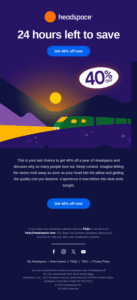
Why it works:
- Strong urgency effect in standout elements, such as the email subject line and header
- Generous discount repeated throughout the email
- Two actionable and visible CTAs (again, the discount is the protagonist)
- Short email copy that emphasizes outcomes
- No unnecessary assets that disorient readers
4. Re-engagement campaigns
Repeat customers aren’t just a source of revenue. Businesses can also capitalize on their preference in the form of word-of-mouth marketing since 48% of consumers recommend brands they feel loyal to.
Therefore, you shouldn’t risk losing your existing customers. Which is why you should create win-back email campaigns to motivate inactive customers to re-engage.
These re-engagement sequences allow you to remind churned audiences of your offerings and re-establish connections.
But there are some tactics to use for better results:
- Show them what you’ve been up to during their inactivity period by introducing new products, services, or features, and sharing industry updates or trends.
- Offer a valuable incentive that’s tailored to the recipient’s interests and past behavior to encourage purchases.
- Leverage polls and surveys to ask them where they think you could improve and tweak your strategy if needed.
- Send non-openers a “last notice email” informing them that you’ll remove them from your email list, and make sure you do if they don’t take action.
Here’s how Asana created a smart re-engagement email including the features dormant customers have been missing out on:
Subject line: You’re missing out on unicorns

Why it works:
- Intriguing yet simple subject line
- Casual tone that doesn’t sound promotional
- Clear sections with matching CTAs that highlight different features
- Blog insights to demonstrate the brand’s expertise
5. Cross-sell/Upsell campaign series
With cross-sell and upsell email sequences, you offer a more holistic experience to people who’ve already purchased.
Brands use cross-selling emails to recommend matching products to customers or prospects. For example, if someone has just purchased a pair of trainers, you can send tailored recommendations for your new gym wear collection.
Upselling on the other hand is about motivating customers to invest in a more expensive product or service and get the best value-for-money option.
Although both strategies suggest a new transaction, they don’t have to scream promotion. Rather than that, you should emphasize how the new product or service update would benefit recipient.
You don’t need an extraordinary design and copy for that. What you do need is good timing. Which means you shouldn’t rush things, delivering such an email immediately after the initial purchase.
Another tactic that does the trick is to throw in a discount or coupon code.
Exactly like AllTrails did, leveraging Independence day for a limited-time upselling campaign:
Subject line: Reminder: Our Independence Day Sale will be ending soon!

Why it works:
- Effective subject line that summarizes the email’s key points
- Includes all relevant details in a short paragraph
- Persuasive copy like the “less-time driving, more time exploring” benefit
- CTA placed both at the email top and bottom to make the discount stand out
6. Cart abandonment email sequences
Some visitors on your website or store will place items in their cart without proceeding to checkout. Does this mean every chance for a conversion is lost? Not necessarily.
They were interested in your brand at first, so you might just need to remind them why they did. This is where abandoned cart email series enter the game.
Now let’s see how you can handle such an email sequence:
- Send the first email within the next hours, centering the content around abandoned products or service benefits, including images, descriptions, and CTAs linking to the checkout page. You can also display reviews and star ratings as long as you don’t overdo it.
- Schedule the second email to go out after 2-3 days, perhaps giving them a limited-time discount or BOGO deal to prompt them to act quickly. To make it even more effective, add a countdown timer that displays the time left to get it.
While abandoned cart sequences are associated with eCommerce, brands from every niche may find a way to recover lost sales with them.
Let’s take this abandoned cart email example by Hulu used to bring back disengaged free trial users:
Subject line: TV Fan, Your Free Trial is Waiting
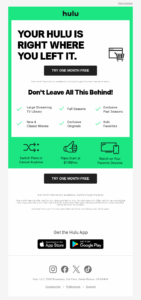
Why it works:
- Email subject line that gets to the point
- Makes the abandoned deal the main focus point
- Prominent and actionable CTA placed at the email header
- List of free trial perks that catches the reader’s eye
- Unique objective supported by an unclutterd layout
Setting up a successful abandoned cart email is easier than it sounds. Email tools like Moosend or Brevo offer professional, ready-made workflows to create these series in a few minutes and let them run on autopilot.
7. Feedback email campaigns
You might do your best to improve your products or services, monitoring analytics, testing tactics, refining your strategy. Yet, your safest bet is to listen to your customers to ensure that you meet their preferences and provide solutions.
One of the easiest approaches to collect their feedback is setting up autoresponders with customer surveys at critical times during their journey. Make sure the process is quick, straightforward, and frictionless to boost completion rates.
Now let’s explore some ideas on how to ask for recipient feedback:
- An eCommerce store can nudge subscribers a few days after they’ve received their order. Don’t limit your feedback request to product quality, though. Instead, collect data for all the stages from order to shipping to measure overall satisfaction.
- For the travel industry, it may be a post-trip or post-checkout survey where customers rate their experience and add a brief comment on what to improve. You could also add a few single-select questions to get insights like waiting time, service quality, value-for-money, etc.
- A B2B company may use such a campaign to learn how helpful their service was after finalizing a project. Another option is to send a NPS survey to ask customers how likely it is for them to recommend your brand to friends and family.
We loved the direct approach in the following feedback request example by Lyft:
Subject line: Enter to win a gift card for feedback
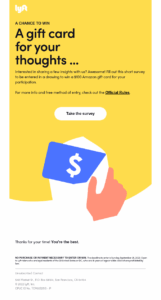
Why it works:
- Minimalistic email design that helps readers focus
- Clear subject line that informs about the incentive
- Engaging copy investing in short sentences, questions, and action words
- Highlights the link to the drawing’s rules to address concerns
- Closes with a simple, friendly thank-you note
8. Renewal emails
Every business wants to keep loyal customers around. Besides re-engagement campaigns, the road to customer retention passes through renewal email sequences for SaaS companies.
What’s the best time to send these emails? A week before their subscription expires is a good start.
Most subscribers will probably open those campaigns and renew in time. If they don’t, make sure to send a second email one or two days before the expiration date.
What about those who miss the deadline? You can use a third email to inform them that you’ll extend their subscription for a few days.
In it, remind them what they’ll be missing if they don’t act fast. You could reinforce your message with use cases and quick wins they can achieve through your service.
This is how YouTube Premium invites customers to stay aboard:
Subject line: Time is almost up, your YouTube Premium benefits end soon – renew now.
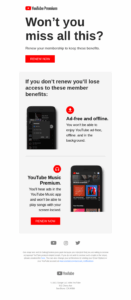
Why it works:
- Starts the email with a question to hook subscribers
- Brightly-colored CTA aligning with YouTube branding
- Ample of white space for enhanced focus
- Makes a unique focus point out of the plan’s benefits
9. Customer loyalty email sequences
Customer loyalty is a long-term challenge where brands reward their returning audiences with special deals, exclusive content, and unique perks.
But these sequenced emails aren’t just about driving repeat purchases.
More than that, they focus on strengthening bonds with your customers and increasing their lifetime value. You may also use customer loyalty series to create brand advocates who promote your business.
Let’s see how you can get the most out of customer loyalty emails:
- Celebrate milestones like anniversaries, birthdays, and specific goals your customers reach using your products or services. Also, throwing in a small reward shows a thoughtful brand.
- Offer exclusive perks like early-bird offers or preview of new products or services to make them feel part of a VIP club that gets first-access before everyone else.
- Share value beyond purchases. Providing resources like tips and tricks, reports, or curated content is an excellent way to engage loyal customers even when they’re not actively buying.
- Invest in brand advocacy. Satisfied customers are your best marketing asset. So, ask for their reviews and testimonials and urge them to follow you on social and share your posts or forward your emails to their contacts.
Subject line: Coming Soon: New Experiences For SkyMiles® Members

Why it works:
- Exclusivity-focused subject line that builds excitement
- Persuasive copy highlighting both the perk and the time left to claim it
- List of the upcoming events and a short description on what to expect
- Has a star rating review at the end without to avoid distracting readers from the core message
Email Sequence Templates
Need more inspiration? Below you’ll find an example of email sequence templates including a first touch point and a follow-up:
1st Email Template
Subject line: [Name], let’s talk!
Hi there, [Name]!
How are you? I am [Name] from [Company name], and I recently saw your profile on [channel].
Our company offers solutions that can free your hands, such as:
- [Solution X]
- [Solution Y]
Do you find this information helpful? Otherwise, is there anyone in your business that could benefit from us? I would love to get in touch and discuss with them.
If you’re interested, reply to this email, specifying your availability for a quick call!
Kind regards,
[Your Name]
1st Follow-up Email Template
Subject line: [Name], I forgot to mention…
Hi [Name],
I hope you’re doing great!
I previously emailed you about helping companies like yours to [mention pain points/solutions offered], and I’m curious to know if you experience similar struggles at work.
Did you get the chance to check our website and spot something you’d love to discuss with us? Then we’d like to jump on a short call this week. Click the link below to choose a time and date that suits your schedule.
Best regards,
[Your Name]
You can tweak the templates above to create your own follow-up sequence with your unique tone of voice to create a consistent experience for readers across different channels.
Email Sequence Best Practices
If you’re convinced that automation workflows are what your marketing and sales team needs to elevate their work, here are some strategic steps to follow:
1. Choose an email service provider
To build the right email sequences, you need email automation software with excellent capabilities to set up autoresponders, automation workflows, and transactional emails.
Here’s what you should be looking for in such a tool:
- Visual automation builder with drag-and-drop functionality for quick setup and customization
- Pre-designed automation workflows for popular sequences, plus conditional logic and a variety of triggers
- A/B testing features to check how different subject lines, visuals, CTAs, and sending times resonate
- Integrations with essential marketing tools like CRMs and loyalty program platforms
- Detailed email analytics with real-time reports to easily track campaign performance
- Efficient customer support and a range of resources to help you in case of questions or issues
To set up your sequences or tweak the existing ones, you should follow the if/then conditional logic, selecting the triggers and the conditions for each sequence.
Like in this onboarding sequence created with Moosend’s automation editor:
If you’re new to email automation, find your top three ESPs, and check their pricing and features pages, plus user reviews to see which covers your needs. Many offer trials to help you navigate the product, so we suggest you use them before deciding.
2. Create converting email sequences
Moving on from the more practical part, it’s time to get creative to deliver beautiful email sequences to your audience. You should create a unified experience for readers across these emails so that they instantly recognize your campaigns.
Most email marketing platforms have newsletter templates that are easy to customize using intuitive editors to save time while ensuring a professional look and feel.
Now let’s take a look at the main newsletter components to tweak:
- Subject line: Enticing, concise, and simple subject lines urge subscribers to open the email.
- Header: A straightforward, branded header reveals the email purpose and sets the tone.
- Layout: Designing clean and structured emails with organized sections makes your campaign readable.
- Visuals: High-quality and relevant visuals catch attention while subtly complementing the email copy.
- CTAs: Strong and clear calls-to-action reflect the email goal, telling recipients what their next action is.
- Email footer: An effective email footer with contact and unsubscribe options, plus links to privacy and return policy build compliance and credibility.
The copy also plays a key role in attracting the right audience, starting from the first email component (i.e., your subject line) subscribers see.
Addressing pain points and emotions with your copy helps your audience trust you. An empathetic, personal tone combined with authenticity is also a golden ticket.
Actionable copy usually motivates readers to decide faster. So does adding a sense of urgency but only when you have a good reason to use this tactic, e.g., time-sensitive discounts and offers.
Like L’ AMARUE does in the following email, focusing its copy on the limited-time nature of the offer while reinforcing it effectively with prominent countdown timer.
Subject line:🚨 30% Off Ends at MIDNIGHT!

3. Make personalization a priority
What makes subscribers open marketing emails every single time? According to research, 46% of them say it’s receiving relevant emails consistently.
So, the more your content aligns with the recipient’s behavior and preferences, the more they’ll engage with it.
For instance, if a user downloads a project management template, your lead nurturing sequence could include tutorial videos or relevant case studies so users can see how they work and the value they bring.
Basically, your email sequences should feel like the next obvious step of their action. When messages reference the subscriber’s previous interactions, you guide them through a journey and toward a goal.
This kind of personalized interaction makes your audience think of you as an ally that anticipates and responds to their needs rather than a brand interrupting their routine with sales pitches.
Busuu’s email is an excellent example of how brands can use the subscriber’s actions to nudge them to take the next step. They also add a short checklist to make the language-learning project more organized and less intimidating.
Subject line: You had a good start on day 1! 👍 So, about making day 2 count…
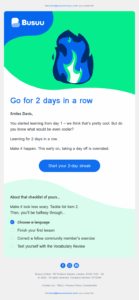
4. Mind your timing and frequency
Some the relevance of some of the email series mentioned depends on the time you send them. So, when scheduling your sequenced campaigns, it’s key to decide on the optimal sending time and frequency.
For example, delivering a welcome sequence a week after signup will probably feel out of time and place. The same goes for sending a feedback request email for a product that hasn’t arrived yet.
When it comes to frequency, different campaigns call for different approaches. For a cart abandonment email, two emails spared throughout a week may be enough to do the trick. More than that may come across as aggressive.
But an onboarding sequence that lands in inboxes daily at a specific time makes sense. Here, consistency is also key since any missed campaign will disrupt the experience and seem like you can’t live up to set expectations.
Whatever you choose, make sure you send emails at a reasonable pace that lets subscribers digest each message before getting the next one.
5. Monitor email metrics
When you start sending out email sequences, it’s essential to keep track of your email metrics to see what works and where there’s room for improvement.
Your tests can include anything from subject lines to layout, even the number of emails you put in a sequence or what kind of tone your audience prefers.
For example, a low click-through rate might signal poor CTA placement. Or that your audience doesn’t understand the value of acting once they get there.
Here are the metrics you should look closely at:
- Conversions
- Click-through rate
- Open rates
- Bounce rate
- Unsubscribe rate
Treating each of them as a standalone metric, though, won’t get you too far. For deeper insights, you should try to connect the dots.
For instance, high click rate combined with low conversions might indicate a mismatch between the promises made and what recipients find at the next step.
It’s also important to check email benchmark data in your industry to know where to aim. However, remember that this is just an indicator, as different audiences have unique characteristics and habits.
Adjust in real-time, see value in the long-run
Email sequences is a great starting point if you want to engage your audience with relevant messages when they matter. So, study the customer’s journey in-depth, prepare effective lead magnets and landing pages, and nurture subscribers with tailored content.
However, you should bear in mind that nothing should be set in stone just because it’s automated. So, try to adjust your strategy based on your subscriber’s level of engagement.
A reliable email automation platform allows you to streamline this by crafting triggered emails and scheduling them to reach subscribers at strategic intervals. Most of these tools also come with testing and reporting features so you can see what works.
If you want to connect with your audience without setting things up from scratch every time, you can sign up for a Moosend account and start using its features for timely and personalized customer interactions.
Email Sequences FAQs
We’ll close with a quick round of questions regarding email sequences:
1. What’s the difference between drip campaigns and email sequences?
Drip campaigns are automated emails with more static content, meaning it doesn’t change based on the subscriber’s behavior. Whereas email sequences tend to have dynamic content that responds to the reader’s actions and attributes for optimal personalization.
2. How many emails should be in a sequence?
It depends on the goal of the workflow and your subscribers’ engagement. Usually, it ranges from 2 to 4 while ore than that may overwhelm readers and lead to negative signals, such as unsubscribes or spam complaints.
3. Are email sequences only for sales and promotions?
Not at all. Many brands use them for other key business objectives like onboarding, education, lead nurturing customer loyalty, and community-building. Plus, the same business may set up various sequenced emails for different purposes depending on their priorities.
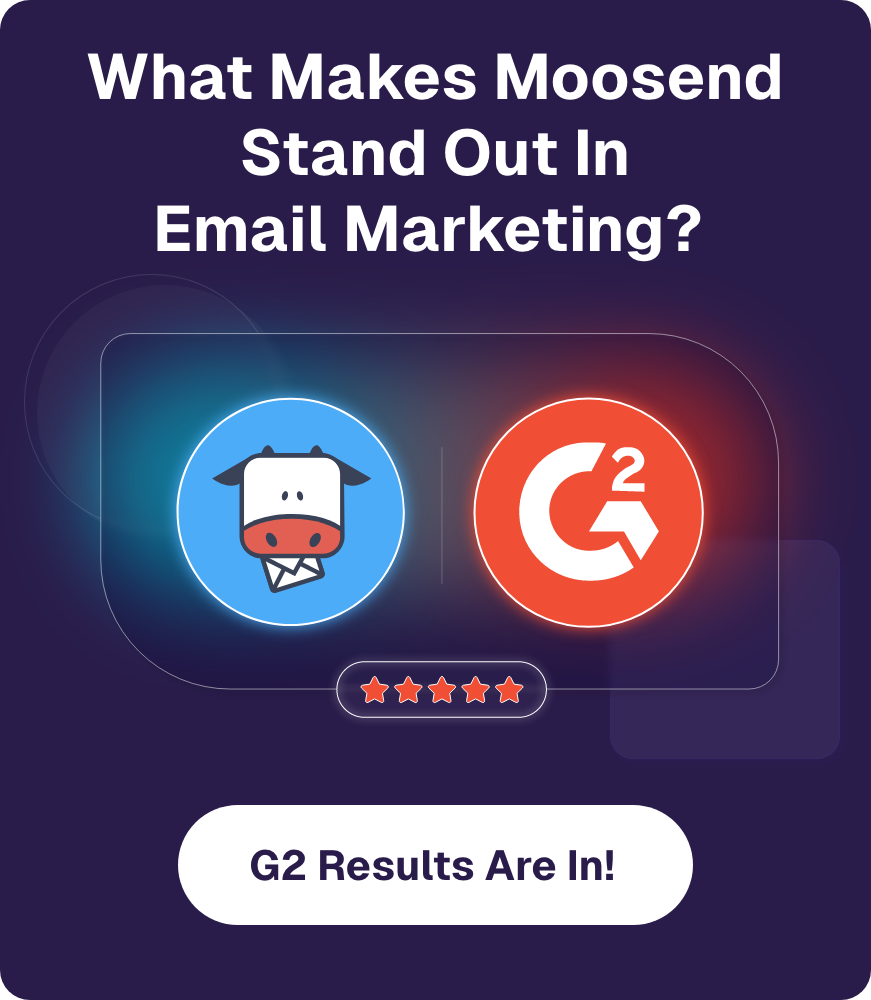


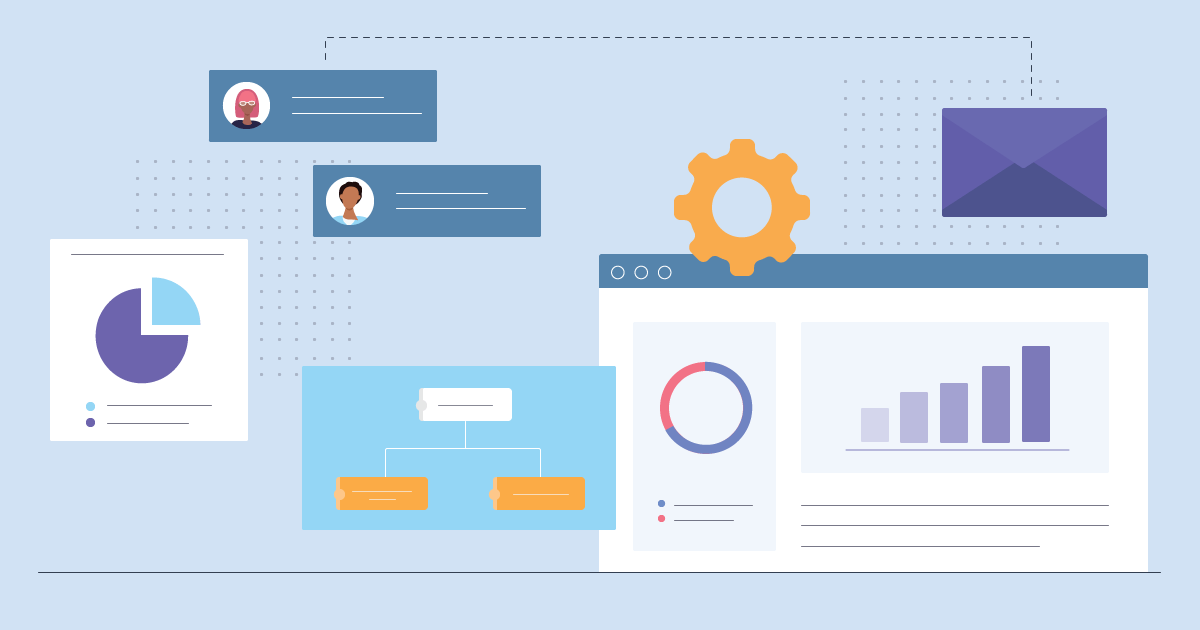
 Published by
Published by
